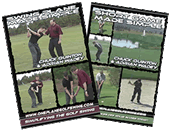Full Swing
Rotary Swing Tour - Anatomical Absolutes of Golf
Rotary Golf Learning Series
Golf Biomechanics Home Page
1. RST Overview
2. Use of the Hips and Core - Driver Swing
3. Biomechanically Correct Golf Setup and Balance
4. Functional Squat and One Legged Exercises
5. Functional Bridge Exercises
6. Inner Thigh/Hip Exercise
7. Back Stabilizer Exercise
8. Push vs. Pull
9. Golf Core Rotation Exercises
10. Golf Swing Weight Shift - Part 1
11. Golf Swing Weight Shift - To the Right - Part 2
12. Golf Swing Weight Shift - To the Left - Part 3
13. Sean O'Hair - Rotary Swing Tour
14. Common Swing Faults Caused by Setup
15. The Takeaway in the Golf Swing
16. Understanding Shoulder Elevation
17. The Role of the Right Arm in the Takeaway
18. Posture's Affect on the Takeaway
19. Golf Instruction - Muscle Activation
20. Tiger Woods Biomechanics
21. Move 2 - Completing the Backswing
22. Move 3 - The Golf Downswing
23. Creating a Golf Swing Plane
24. Effects of Bad Ball Position
25. 9 to 3 Drill
26. Move 4 - The Follow Through
27. Common Faults in the Follow Through
28. Tiger Woods - Getting Stuck - Downswing
29. Throw the Ball Drill
30. Right Arm Only - Downswing Drill
Rotary Swing Fundamentals
1. Golf Swing Fundamentals Home
2. Athletic Address Position
3. Body Movement
4. The Arms in the Golf Swing
5. Golf Spine Angle
6. Golfswing Takeaway
7. Proper Golf Grip
8. Golf Swing Rhythm Drill
9. Starting the Swing
10. Proper Divot
11.Forearm/Shaft Alignment
12. Head Behind the Ball
13. Golf Swing Wrist Hinge & Cock
14. Hip Turn
15. Hip Rotation Through Impact
16. Takeaway Chin Line
17. Passive Arms in the Golf Swing
18. Biomechanically Shorten Backswing
19. Rotation vs. Tilting Shoulders
20. Golf Swing Transition Bump
Rotary Golf Swing Drills
1. Golf Swing Drills Home
2. Body Drill
3. Impact Bag
4. Divots Left Tee Drill
5. Golf Baseball Swings
6. Broom Drill
7. One Leg Drill
8. Headcover Drill
9. Foam Roller Drill
10. Ben Hogan Pane of Glass
11. Shaft Plane Drill
12. Slide the Shaft Drill
13. 9 o'clock Swing Plane
14. Rotary Drill
15. Penetrating Flight Drill
16. In to Out Tee Drill
17. Neck Tie Drill
18. Bucket Drill for Synchronization
19. Lag Drill - Improve Your Golf Swing
Faults and Fixes
1. Faults & Fixes Home
2. Understanding Your Misses
3. Fixing a Hook
4. Fixing a Slice
5. Hitting Fat
6. Hitting Thin
7. Shots off the Toe
8. Shots off the Heel - Shanking
9. Left Side Breakdown
10. Pulled Shots - Student Analysis
11. Slicing
12. Coming Too Far From the Inside
Advanced Technique
1. Advanced Technique Home
2. Impact vs Address
3. Fade vs Draw
4. Hitting a Draw
5. Hitting a Fade
6. Hit It Low
7. Hit It High
8. Tiger Woods 2 Iron Stinger
9. Driver off the Deck
10. The Three Releases
11. Pinky Grip
12. Arms vs Body Release
Rotary Hitter
1. Rotary Hitter Intro
2. Impact Position
3. Chip Stroke
4. Hitter Backswing
5. Shoulder Turn and Right Arm Throwing Motion
6. Hitter Takeaway
7. Hitter vs Swinger
8. Right Hand Pressure Point w/ the Pure Ball Striker
Two Plane
Golf Impact Video Series
Short Game
1. Swinging Over the Top
2. Flat Left Wrist
3. Driver vs. Irons at Impact
4. Impact Fix Drill
5. Importance of Proper Grip
Bomb Your Driver Series
1. Bomb Your Driver Home Page
2. Ball Speed
3. Clubface Roll
4. Driver Sweetspot
5. Optimum Ball Launch Angle
6. Driver Golf Ball Spin Rate
7. Increase Clubhead Speed with More Lag!
8. Tiger Woods Most Inefficient Driver on PGA Tour
9. Driver Head Center of Gravity Design
Performance Putting Series
Putting
Mental Game
1. Forearm Shaft Alignment
2. Putting Distance Control
3. Putting Shaft Drill
4. Putting Acceleration Drill
5. Putting Hand Dominance
6. Face Angle in the Putting Stroke
7. Pendulum Putting Stroke
8. Putting Fitting - Shaft Length and Setup
Wedge Play
Mushin Golf
Golf Instruction
1. Mental Game Home
2. Introduction
3. Taking it to the Course
4. 10 Mental Principals
5. Confidence
6. You Are An Athlete
7. Spring Golf
8. Ultimate Destroyer
9. How To Practice
10. Developing a Mental Putting Routine
Course Management
1. Rotary Swing Golf Academy
2. In Person w/ Chuck Quinton
3. Driver Fittings
4. Demo Matrix Shafts and Nakashima Heads
5. Online Golf Lessons
6. Flightscope Kudu Launch Monitor at RSGA
Golf Equipment
1. Properly Fit Shafts
2. 2006 Golf Ball Review
3. Using a Launch Monitor
4. Sandwedge Bounce Angle
5. Flightscope Kudu Launch Monitor at RSGA
6. Demo a Matrix Driver Shaft!
7. Eyeline Golf Putting Plane
Professional Swings
Pro Golf Swing Sequences Home
Ben Hogan
Member's Swings
Golf Fitness
1. Ben Hogan's Swing
2. Ben Hogan's Shoulder Plane
3. Ben Hogan's Swing Face On
4. Ben Hogan's Swing Down the Line5. Ben Hogan - Reverse Pivot?
6. Ben Hogan's Address Position
Tiger Woods
1. Tiger Woods Swing Dynamics
2. Tiger Woods New Swing with Hank Haney
3. Tiger Woods Address
4. Tiger Woods Takeaway
5. Tiger Woods Backswing
6. Tiger Woods Downswing & Impact
7. Tiger Woods Most Inefficient Driver on PGA Tour
Chuck Quinton
1. Quinton 6 Iron Down the Line
2. 6 Iron Face On
3. Driver Face On
4. Driver Down the Line
5. Chuck Quinton DTL Analysis
6. Quinton Face On Swing Analysis
7. TaylorMade Performance Lab
Paul Dickinson
Stuart Appleby
Ernie Els Golf Swing DTL
Ernie Els Grip
Jose Maria Olazabal
Annika Sorenstam
Peter Jacobsen
Sam Snead
Adrian Wadey Face On
Adrian Wadey Down the Line
Tyler Aldridge 2007 PGA Tour Qualifying School
1. Golf Fitness Exercises
2. Hitting with Your Core
3. Balance on Swiss Ball
4. Golf Fitness Bridge Exercise
5. Stretching the Core
6. Advanced Leg Exercises
7. Intermediate Let Exercises
8. Losing Spine Angle in Golf Swing
Membership Info
Golf Tips & Info
1. One Plane vs. Two Plane Swing
2. One Plane Swing in Depth
3. Model Golf vs. One Plane
4. My Swing Philosophy
5. List of One Plane/Rotary Swing Instructors
6. Golf Chat Live Transcript
7. Golf Blog
8. Analyzing Golf Ball Flight
9. Stop Casting the Club
10. Causes of a Slice
11. Core Performance Golf
12. Efficiency of Movement
13. Fred Couples Golf Swing
14. Releasing the Golf Club
15. Hank Haney's Swing with Tiger Woods
16. Iron Shaft Survey
17. Key Components to Hardy's Swing
18. Losing Spine Angle
19. Mixing One and Two Plane Swing Fundamentals
20. Mushin Golf
21. Passive vs. Active Arms
22. Problem with Jim Hardy's Swing
23. Secret of Clubhead Lag
24. Right Arm in Golf Swing
25. Stuart Appleby's Golf Swing Video
26. Clubface Angle Video
27. Tiger Woods New Swing
by Chuck Quinton
Tiger Woods & Golf Biomechanics - Rotary Swing 2.0 |
Rotary Swing Golf |
by Chuck Quinton
Perhaps no golf swing has ever been studied more than Tiger Woods' swing. I have personally invested atleast 1,000+ hours in the pursuit of understanding more about how he swings the club and uses his body. Without fail, the one thing that has always stuck out in my mind was the incredibly powerful unwinding of his left hip and core during the transition and downswing. No one appears to use this part of their body to power the downswing more than Tiger and perhaps no one else is as powerful as Tiger, pound for pound. Sure, there are some that can swing as fast or faster, but they may either be stronger, taller or simply not as consistent. Tiger's swing has mesmerized millions of people and had thousands of golfers attempt to imitate it, but none have succeeded in understanding the complexity of the motion - until now.
Having spent time recently with Alison Thietje of www.MotionMemory4Golf.com, a biomechanics expert, a greater understanding of Tiger's unique motion came to me. It was, in fact, an epiphany really. Having tinkered with learning Tiger's body movements over the years, there were things that I felt I just couldn't achieve because I wasn't strong enough, flexible enough or simply not coordinated enough. It turns out, none of the above are true. The truth was that I wasn't using the core muscles correctly to swing the club. Being a golf instructor known for teaching the use of the core muscles to power the swing, I found this interesting, but Alison helped teach me udnerstand the proper feelings and sequence of the muscles that fire and the results were astounding.
Below, I have posted some screen captures to show you the similarities between a Rotary Swing 2.0 in progress after only one week and the current swing of Tiger Woods.
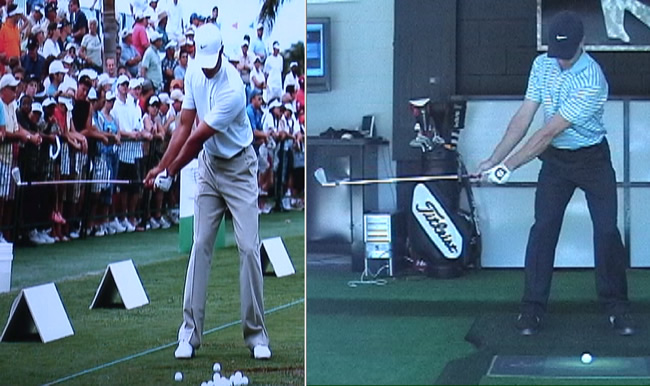
Halfway back, the takeaway movements of the body look very similar. The hips have turned a minimal amount, the turn is being completely controlled by the core and back muscles.
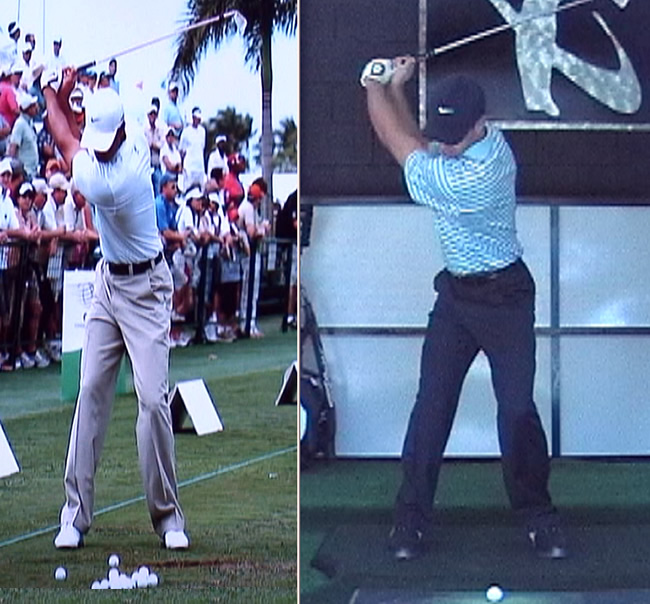
At the top of the swing, both of us are fully torqued up and ready to uncoil the body using the muscles of the core.
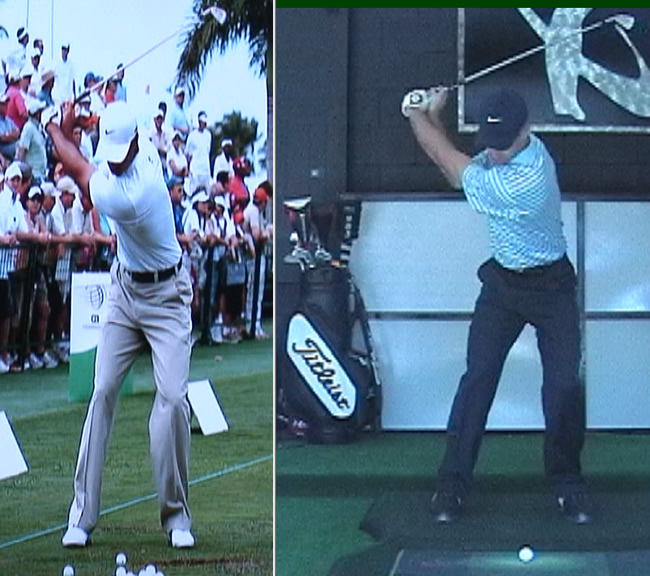
Undeniable evidence here of the transiton and downswing movements being driven by the core and not the shoulders. Note how our backs are still facing the target but we've made a very clear move onto the left foot while the arms are passive and allowed to fall.
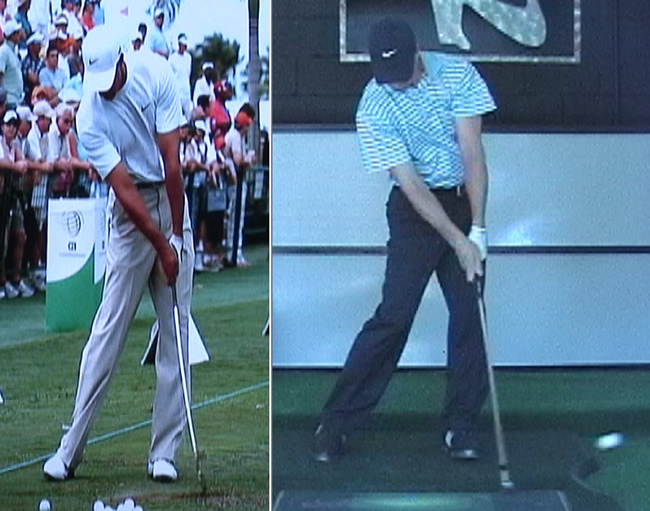
A split second after impact, the two positions are very similar once again. The weight is fully on the left heel, the head is back and core is continuing to pull the body around to the left.
In less than a week, my swing now very closely resembles that of Tiger Woods. Obviously, the idea in golf instruction is not to replicate someone else's golf swing, I obviously believe in getting the golfer to achieve a functional swinging motion rather than a cosmetic one, however, this is purely built out of function. In other words, in working through the biomechanics of the body, I achieved positions that match Tiger's because Tiger uses his body biomechanically correctly in the golf swing! Trying to match Tiger's positions based on what you see on video as so many have tried before is completely futile because you are simply learning to match visible positions and it not possible to match his positions without using and feeling the correct muscles as the motor of the swing. You must use the correct core muscles in the correct sequence, and that's what the Rotary Swing 2.0 is all about. Now, for those of you following the Rotary Swing 2.0 discussions on the golf blog, you may start to piece some things together from my posts:
- Tiger Woods uses his body better than anyone on the PGA Tour, hands down.
- The body only has ONE WAY to biomechanically swing the golf club at maximum efficiency and power with minimal perceived effort for generating maximum power.
- The plane and path of the swinging motion of the club and arms is secondary in nature to the biomechanically correct movements of the body.
- The Rotary Swing 2.0 swinging motion is even more core centric than before.
- The core Rotary Swing fundamentals remain, but are now backed up by medical science.
- Things in the Rotary Swing that there was no definitive answer on, such as stance width, balance, what starts the backswing, etc. now have definitive answers that are absolutes based on the biomechanics of the body.
- The Rotary Swing 2.0 is a swing model that, because it is biomechanically correct, will dramatically lower your risk of injury and reduce or completely eliminate pain that you have in your golf swing currently. (Learn more about my hip and knee pain in the golf blog.)
- If you've ever wanted to understand the movements of Tiger Woods, you will now finally understand them!
- Positions that you never thought achievable due to your flexibility or strength such as making a full shoulder turn ARE TOTALLY ACHIEVABLE when you use the correct muscles. In fact, most everyone can make a full shoulder turn when done correctly!
Of all those interesting points, perhaps the most fascinating of all is injury prevention. It's amazing how many people undergo surgery for golf related injuries each year, and most, if not all could be prevented by swinging the golf club the way the body was designed! So, if you have golf related injuries, soreness, aches or pains, you will want to pay very close attention to the new content coming to the Member's Vault over the coming months! For now, stay tuned to the Golf Blog as it is often updated several times a day!
|
|
|
| ||||||||

